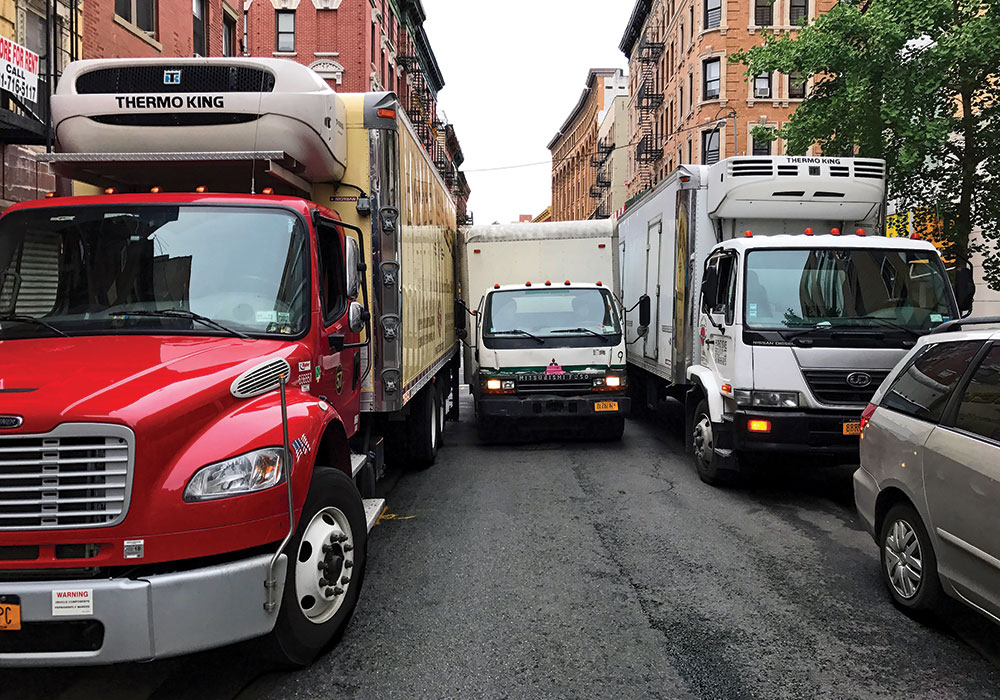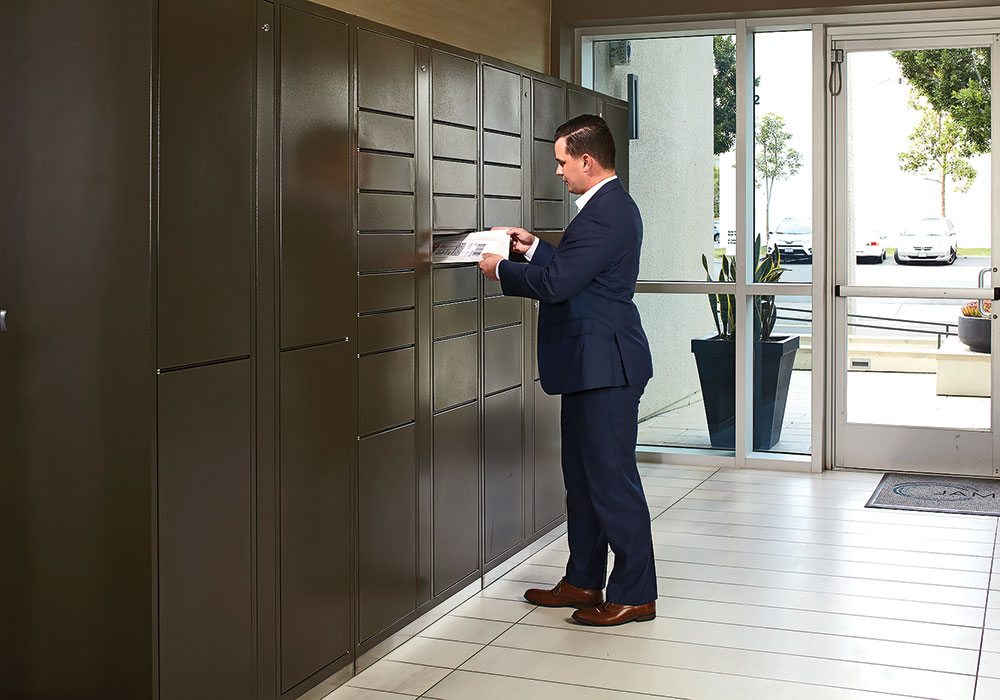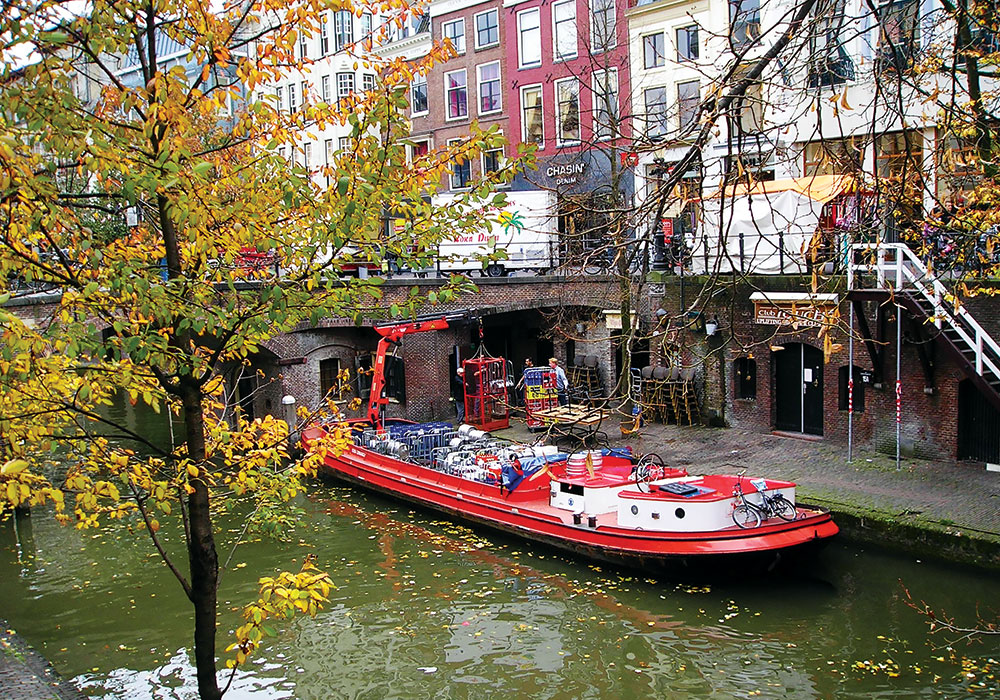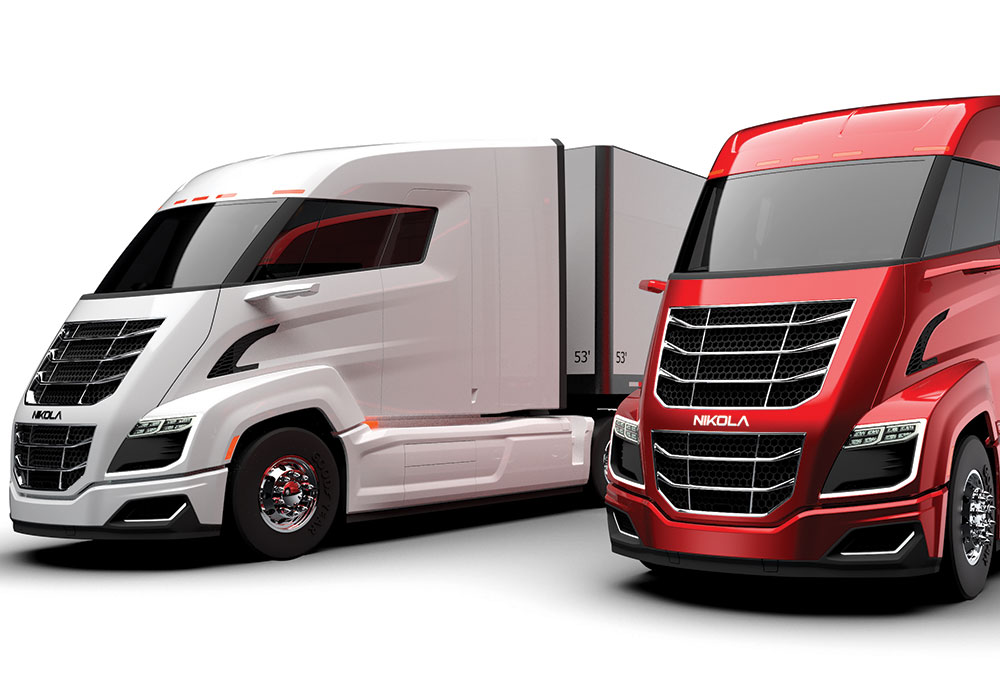Planning November 2019
Freight Can't Wait
Eight strategies to keep the delivery trucks rolling.

This tight squeeze on a New York City street is a not-so-rare sight thanks to our ever-increasing demand for deliveries around the clock. Photo by Tom Visée.
By Tom Visée, AICP, MPM
The movement and delivery of goods is essential to society — and always has been. But freight planning doesn't get the recognition it deserves, even among planners. In the e-commerce age, effective, comprehensive, and thoughtful freight planning is more important than ever, and the need will only grow.
In historic or dense urban areas, the demand for deliveries is rising, but the available infrastructure is static without space to expand. Light commercial vehicles crowd communities and distribution centers are sprouting in rural places and dense metropolitan places alike to meet customers' ever-increasing expectations, including one- and two-hour delivery promises. The space where the actual delivery occurs, the curb, is heavily under pressure by a growing number of competing uses (see "Curb Control," June 2019). Despite the rise of e-commerce, traditional brick-and-mortar stores are here to stay, and shoppers expect them to be stocked with their favorite commodities, which have to get there somehow.
In short, we all depend on trucks to move the goods. But they also emit noise and air pollution, contribute to congestion, and can threaten the safety of other users of the public way. Here's a look at eight approaches to plan for freight in your community before it's too late.
1. Schedule Off-Hour Deliveries

Learn more about NYCDOT's Off Hour Deliveries (OHD) program. Photo courtesy NYCDOT.
Off-hour deliveries aim to reduce daytime congestion with deliveries in the evening and at night, focusing on the underused road capacity at those hours. The strategy doesn't work in all industries, but it is well suited to restaurants and some retail supply chains.
Communities benefit from less congestion, cleaner air, and safer streets. Receivers have fewer missed or late deliveries. Stores can get products on the shelves before customers arrive the next day. Carriers profit from lower costs due to shorter trips or more deliveries per trip, while their trucks don't have to jockey for curb space, resulting in less double parking and subsequently fewer tickets.
A major challenge to nighttime deliveries is noise, so abatement measures are critical in mixed-use or residential areas. In Europe, strict laws require delivery companies to use vehicles and delivery equipment that operate more quietly. Absent those rules in the U.S., freight companies still can and should train staff not to shout and slam doors. Quieter equipment and directional low-pitch back-up alarms can help, but fleet owners are unlikely to invest in these technologies without clear incentives or regulations such as a municipal noise code.
Another challenge is convincing receivers of the advantages of OHD, since they tend to fixate on costly staff attendance at night. There are ways to work around that barrier, including technological ones and good old-fashioned trust and relationship building.
The New York City Department of Transportation launched an OHD program in 2019 after an initial pilot. The program focuses largely on outreach to relevant parties, including advice on achieving buy-in from receivers and carriers and a recognition scheme to publicly reward them.
2. Adjust Building Codes and Off-Street Loading Requirements

Photo by Getty, courtesy Parcel Pending.
Where do the final 50 feet of urban delivery begin? Too often it's at the curb, even if buildings have docks to accommodate off-street loading and unloading. However, older buildings' loading facilities are often from an era when trucks used to be smaller and lower, or they're taken up by something unrelated like a trash compactor or the building superintendent's car.
Cities can stimulate off-street loading by requiring not only a minimum number of loading docks, but also minimum dimensions, applying the rules to new construction as well as to renovations of apartment, retail, and office buildings.
Some loading docks even feature an enormous lazy Susan to accommodate front-in, front-out movements that improve safety and prevent the need for trucks to reverse in the street and add to congestion. A reservation system can ensure trucks don't all arrive at once, which results in queues and idling vehicles.
Holland, Michigan, is considering the use of a related popular practice: designated delivery zones, including those in the form of common carrier storage lockers in building lobbies. "Our city is booming, [with several] apartment buildings going up in our downtown area," says Holland mayor Nancy De Boer. "We are willing to accommodate package deliveries by creating a commercial vehicle loading zone at the curb but wish to keep these small and efficiently used. So we are considering strategies that also minimize truck dwell times, such as a mail room or a parcel locker in the lobby (above), to increase the turnover of this curb space." Reserving otherwise leasable space for parcels isn't always an easy sell to building owners. That's where freight-focused building codes and other local requirements can come into play.
3. Encourage Collaborative Procurement
Using a preferred vendor program for tenants in one office building or among companies located in the same neighborhood consolidates freight and therefore limits the number of trucks coming into a city. Besides reducing truck traffic, streamlining the number of retailers used could result in discounts for the tenant groups.
A successful case is the West End Buyers Club in London. "We developed a preferred supplier scheme for the West End of London with Business Improvement District partners across waste, travel, courier services, and fresh office supplies," says Tom Linton-Smith, project manager for the Cross River Partnership. Once the program was in place, the group continued to work with businesses and communities to improve efficiency, and now, sustainability. "CRP is currently working on an ultra-low emission supplier directory," he adds.
4. Have a Freight Plan
A freight plan or truck management plan is a document usually created by a local government that describes how:
- Freight mobility can be improved given the existing infrastructure
- Commerce and industry can thrive, while the negative externalities associated with freight movement are reduced
- Government, the freight industry, and the community can collaborate in an effective partnership
The plans typically aim to simultaneously improve the quality of life for residents and the economic vitality for local businesses by providing for the efficient, environmentally responsible, safe, and equitable movement of goods. The planning process can be long and intense due to the high level of stakeholder involvement required. Shippers, receivers, trucking industry lobbyists, civic associations, and fellow city agencies all need to be involved, and regional coordination with metropolitan planning organizations and neighboring cities is often necessary to arrive at a comprehensive freight strategy with tangible measures.
Every city does it a bit differently. Some plans focus on just trucks, others include more modalities; plans can have different focus areas, such as employment, rather than congestion, or the environment. Inspiration is readily available from around the globe (see list at left). Even UN Habitat has a chapter dedicated to urban goods transport in its Planning and Design for Sustainable Urban Mobility guidance document.
Freight Plans
Last Kilometre Freight Plan, Melbourne, Australia
The Stockholm (Sweden) Freight Plan
2007 London (UK) Freight Plan
Abu Dhabi Multimodal Freight Master Plan
Freight Master Plan, Portland, Oregon
5. Design a Truck Route System
Designing a truck route map is a very low-tech, easy-to-realize strategy to channel goods transport and heavy loads to only those roads designed to handle them and away from sensitive locations. In an effective plan, residential neighborhoods would only see a truck if the delivery destination is within that area.
Success depends on information and enforcement. An awareness campaign needs to include maps for carriers that frequent the area and truck route signage. Agencies should provide the information in GIS format so it can be integrated into truck navigation systems. Law enforcement has to ensure that truckers only deviate from the dedicated truck routes if it means taking the safest, most direct, or only way to get to their destination. Their bill of lading, a document showing the truck's loads and their destinations, must support the chosen route.
Bismarck, North Dakota, has established truck routes and adjusts them annually, says traffic engineer Mark Berg. "The city works with the trucking industry to see where they go and upgrades the pavement where needed. We even use a secondary system with maximum truck loads solely for the springtime, when the underground is thawing and roads are more prone to damage."
6. Use Urban Consolidation Centers

European and municipal subsidies helped the Dutch city of Utrecht make the switch to electric-propelled zero-emission barges to deliver kegs of beer and collect waste. Photo by Steve Edwards, Flickr.
Consolidation is aimed at reducing the impact of deliveries in a specific retail delivery environment. Instead of many trucks bringing a partial load into, for example, a sensitive historic city center, consolidation guarantees that only full trucks go in, with all of its goods destined for that area.
The use of UCCs can increase shipping costs. These can be offset if the time spent waiting for a full load allows stakeholders to address other concerns. For instance, they can perform advance security checks for airport terminal deliveries or unwrap and hang clothes to minimize storage space needed in stores. The practice can also protect inner-city air quality, particularly if low-emission last-mile delivery vehicles are used.
The Dutch city of Utrecht employs a UCC strategy to protect its historic wharves along the main canal, which can't take the vibrations of heavy trucks. Goods are consolidated outside the historic core, and then delivered to the retail stores along the wharves by lightweight electric vehicles pulling multiple small trailers. Barges provide the restaurants with kegs of beer (above) from a similar consolidation center and use the waterway to collect waste.
7. Create Dedicated Curb Space
Dedicated curb space for truck loading and unloading allows for commercial vehicles to park close to their destination, eliminating the need for double parking or circling around the block. This form of curb management can be fitted to the local needs, changing its beneficiary based on the time of day or day of the week. This strategy depends heavily on strict enforcement but can make a big difference.
The Seattle Department of Transportation relies heavily on this seemingly simple strategy to keep the city accessible while multiple major arteries are being reconstructed simultaneously. "Our approach is to prioritize commercial and passenger loading in the Center City as much as possible," says SDOT parking strategist Mary Catherine Snyder, who notes SDOT is also working in partnership with the University of Washington's Urban Freight Lab to find innovative enhancements that reduce the amount of curb space needed for commercial loading zones. "For example, we are testing vehicle detection sensors together to see if availability data is helpful at designated Commercial Vehicle Load Zones to improve urban goods delivery efficiency."
8. Support Fleet-Specific Programs

Two American manufacturers have added electric semitrucks to their product lines. The Nikola Two (pictured) from the Nikola Motor Company and the Tesla Semi will be available soon. Photo courtesy Nikola Motor Company.
Communities can also tackle many issues at the source: trucks. Cities are integrating safer truck equipment in their contracts with private companies and requiring training for urban driving conditions and interaction with vulnerable road users. Side guards prevent cyclists from sliding underneath a truck. Over-the-hood mirrors and sloped or no-hood designs increase visibility from the cab. Peep windows in the passenger door reveal pedestrians, cyclists, and even small vehicles alongside.
Environmentally friendly fleet improvements include vehicle procurement policy shifts: cleaner fuel vehicles, refrigeration trucks cooled with nitrogen or electricity to reduce greenhouse gas emissions. Light- and medium-duty electric trucks are already available, and Nikola Motor Company and Tesla promise heavy-duty electrically powered trucks in the very near future.
Alternatively powered or cleaner diesel trucks can be expensive, but local and state government incentives can help. That is the approach in the Hunts Point and Port Morris communities in the Bronx in New York City, where residents suffer disproportionately from local trucking activities, including higher asthma rates than elsewhere in the city. The Hunts Point Clean Trucks Program provides financial incentives to local fleet owners that replace or retrofit trucks (or their engines and exhaust systems) to run cleaner. It also requires vehicle safety enhancements to be installed and maintained on each qualifying truck in accordance with the city's comprehensive Vision Zero safety plan.
"The program has funded four rounds of cleaner and safer trucks, replacing, retrofitting, or scrapping about 600 older heavy polluting diesel trucks and 28 older heavy polluting diesel fueled transport refrigeration units," says Susan McSherry, director of alternative fuels for the New York City Department of Transportation.
Final Thoughts
There are many different approaches to dealing with goods movement in urban environments. Planners and their communities have options for meeting the particular challenges — ranging from land-use planning to infrastructure customization to politics — that impact good freight planning.
History has proven that continuing on the current path will not reduce congestion or improve the livability of cities. Proactive planning and alternative strategies must be considered. The time to act is now: Freight can't wait.
Tom Visée is a freight planner for HDR in New York City. He specializes in accessibility challenges of ports and dense urban areas and is a frequent speaker at APA's National Planning Conferences.


